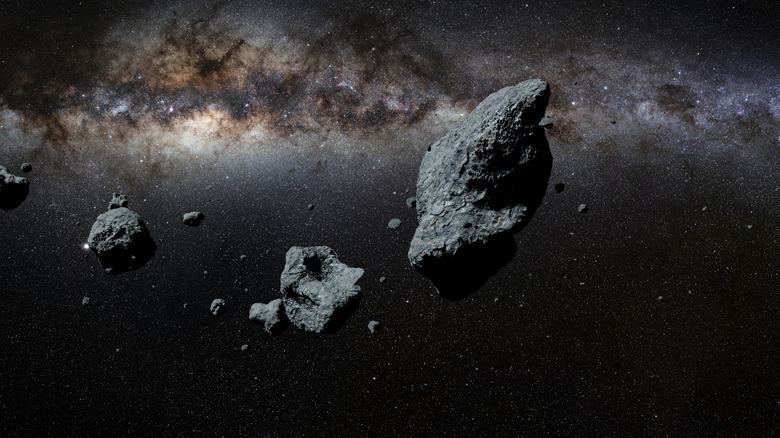Don't Worry About The Asteroid Passing By Earth On Saturday
A huge asteroid, bigger than the Empire State Building, will fly past Earth on Aug. 10. Named 2006 QQ23, it's actually is one of seven asteroids that will pass by Earth during August – yes, you read that right!
Sounds, well, pretty scary, right? But there's no need to fear, says NASA. Here's what'll happen, and why a close brush with an asteroid shouldn't cause Earth any harm or damage.
So How Are Experts Tracking the Asteroid
So How Are Experts Tracking the Asteroid
NASA's Center for Near-Earth Object Studies (CNEOS) is tracking asteroid 2006 QQ23. The asteroid is 1,870 feet in diameter, larger than the Empire State Building and traveling at a speed of 10,400 miles per hour. Although it will pass by Earth on Aug. 10, it will still be 4.55 million miles away. For reference, the moon is an average of 238,855 miles away from the Earth.
The asteroid is categorized as a Near-Earth Object (NEO), and one of more than 10,000 objects that have passed by the planet in a similar way since 2013. NASA doesn't consider 2006 QQ23 to be a threat since it won't make impact. So there's no need to panic or worry about it causing a catastrophe.
So What About Those Other Seven Asteroids?
So What About Those Other Seven Asteroids?
2006 QQ23 is one of seven asteroids that will fly by Earth in August. The first was asteroid 2019 ON, which zoomed by without any incidents on Aug. 1, and the second will be 2006 QQ23 on Aug. 10. The third asteroid, 454094 (2013 BZ45) will pass by on Aug. 12. They will be followed by asteroid 2018 PN22 on Aug. 17, 2016 PD1 on Aug. 26, 2002 JR100 on Aug. 27 and 2019 OU1 on Aug. 28.
Although NASA continues to monitor all seven of the asteroids, it doesn't classify any of them as dangerous for Earth. Meanwhile, you'll be able to see the Perseid meteor shower, which will reach its peak from Aug. 11 to Aug. 13. NASA recommends watching the meteor shower late at night, such as around 2 a.m., or at dawn.
Putting the Threat In Perspective
Putting the Threat In Perspective
Should you be worried about a large asteroid hitting the Earth? The short answer is no because it's a rare occurrence. Most large objects that are headed for Earth burn up in the atmosphere and rarely make an impact. NASA has found about 20,000 near-Earth objects so far.
It's easier to detect the larger objects, which pose a bigger threat, than smaller ones. NASA estimates there may be about 25,000 near-Earth objects that are bigger than 460 feet. Scientists estimate that larger asteroids may make impacts on a less frequent basis, such as "on the scale of centuries to millennia."
Defending the Planet from Asteroids
Defending the Planet from Asteroids
Asteroid 2006 QQ23 and the other six near-Earth objects may not pose a threat in August, but it's possible for something to be a problem in the future. This is why NASA uses multiple planetary defense methods to keep Earth safe. Its Planetary Defense Coordination Office (PDCO) is in charge of managing these systems and focuses on early detection of potential hazards.
NASA monitors and tracks objects near Earth, such as asteroids and comets. NASA gathers as much information as possible about the objects to evaluate the danger of them making impact with the planet. Usually, the objects don't pose a threat, but NASA is preparing to deflect them if necessary.
NASA's Double Asteroid Redirection Test (DART) mission is set to launch a spacecraft in 2021 that should be capable of deflecting an asteroid. The goal of the mission is to change the speed and path of an asteroid that could pose a threat. DART will aim for a small moonlet as a test object in 2022. Telescopes and radar on Earth should be able to detect this collision and track it.
References
- CNN: An Asteroid Bigger Than the Empire State Building Is Passing by Earth Next Week.
- Astronomy: The Sky This Week from August 2 to 11
- NASA: Asteroids
- NASA: 2006 QQ23
- NASA: How Far Away Is the Moon?
- NASA: 2019 ON
- NASA: 454094 (2013 BZ45)
- NASA: 2018 PN22
- NASA: 2016 PD1
- NASA: 2002 JR100
- NASA: 2019 OU1
- NASA: Perseids Peak August 11-13
- NASA: Planetary Defense Frequently Asked Questions
Cite This Article
MLA
Bandoim, Lana. "Don't Worry About The Asteroid Passing By Earth On Saturday" sciencing.com, https://www.sciencing.com/dont-worry-about-the-asteroid-passing-by-earth-on-saturday-13720753/. 9 August 2019.
APA
Bandoim, Lana. (2019, August 9). Don't Worry About The Asteroid Passing By Earth On Saturday. sciencing.com. Retrieved from https://www.sciencing.com/dont-worry-about-the-asteroid-passing-by-earth-on-saturday-13720753/
Chicago
Bandoim, Lana. Don't Worry About The Asteroid Passing By Earth On Saturday last modified August 30, 2022. https://www.sciencing.com/dont-worry-about-the-asteroid-passing-by-earth-on-saturday-13720753/
